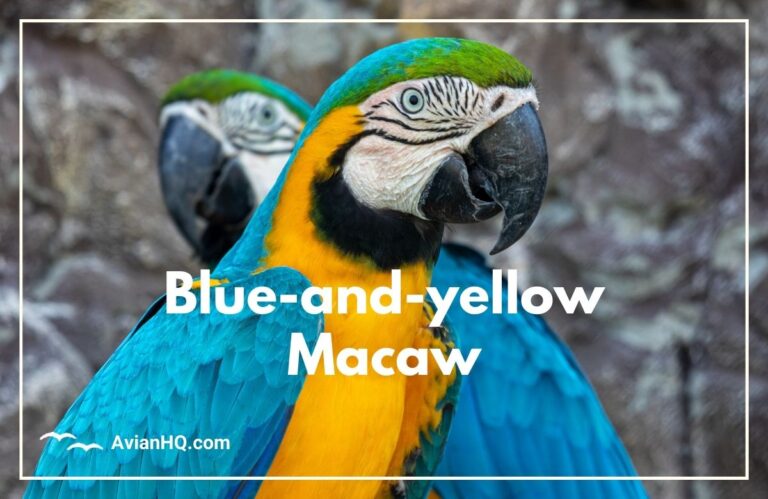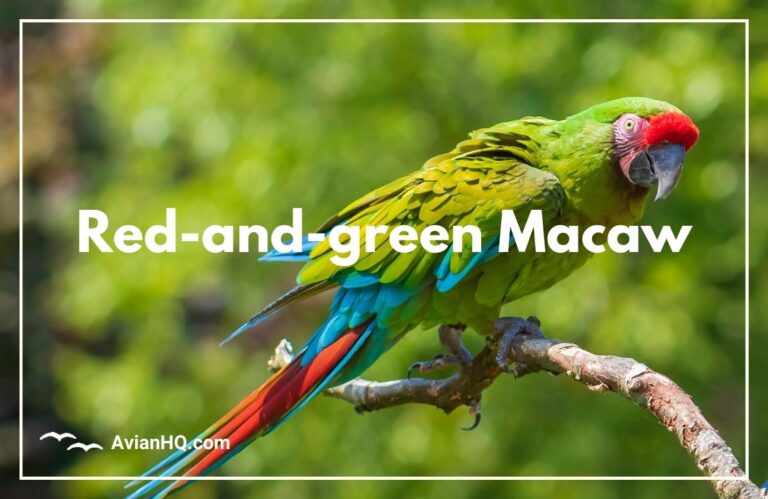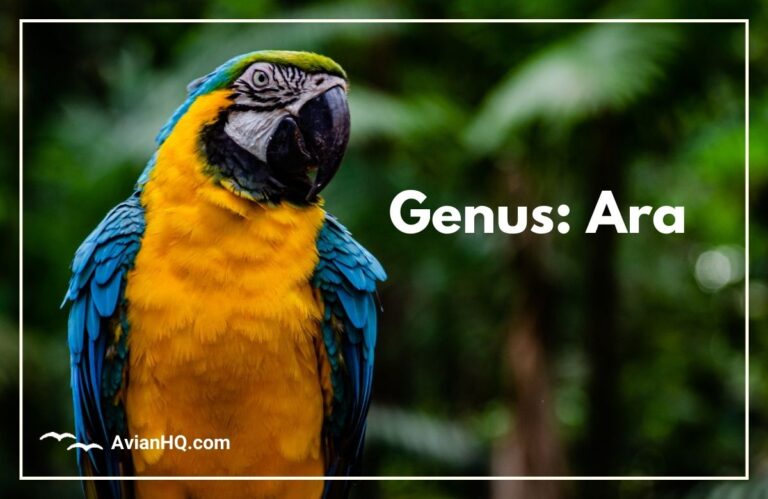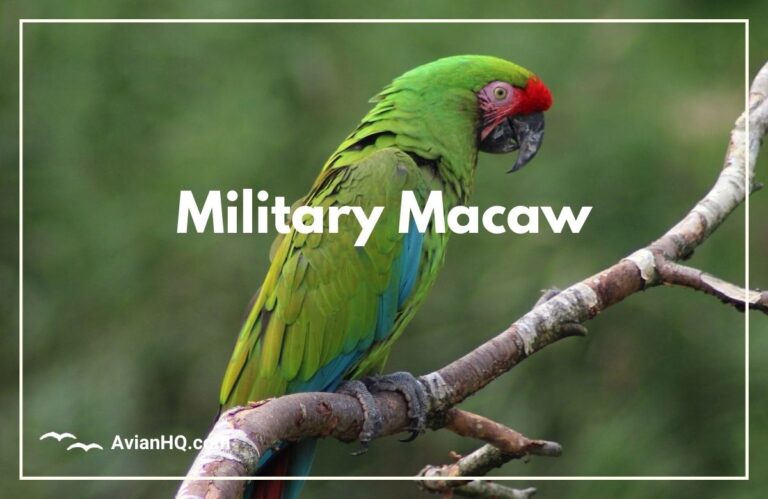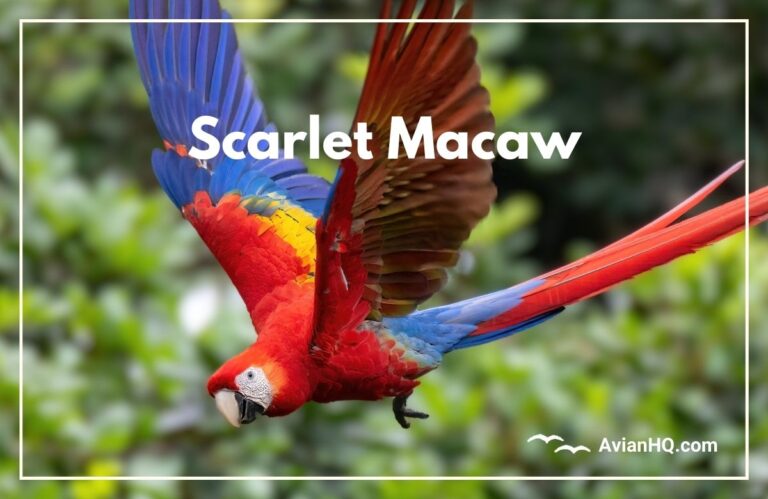Great Green Macaw (Ara ambiguus)
Have you ever seen a bright green parrot with a red forehead soaring over the rainforest canopy? If so, you may have spotted the magnificent Great Green Macaw! This endangered bird is the second largest parrot in Central and South America, and faces a number of threats to its survival.
The Great Green Macaw (Ara ambiguus) inhabits tropical forests from Honduras to Ecuador. Its bright green feathers and long pointed tail make it easy to identify. An adult Great Green Macaw measures 33.5-35.5 inches (85-90 cm) long and weighs around 2.9 pounds (1.3 kg).
These colorful parrots live in small groups, using their strong beaks to crack open hard nuts and seeds. They nest in holes in tall rainforest trees, laying 2-3 eggs at a time.
Sadly, there are only 500-1000 Great Green Macaws remaining in the wild. Loss of rainforest habitat is the main threat facing this species. Many conservation efforts are underway to protect remaining populations.
This article will cover everything you want to know about Great Green Macaws – their natural history, current conservation status, and the efforts being made to save them. We’ll also highlight some amazing facts about these birds along the way. So read on to learn more about this impressive and imperiled parrot!
History and Taxonomy
The Great Green Macaw was first described scientifically in 1801 by French naturalist François Le Vaillant. He gave it the name “le grand Ara militaire” but acknowledged that it may be a separate species rather than just a variant of the Military Macaw.
In 1811, the German naturalist Johann Matthäus Bechstein officially named the species Psittacus ambiguus, using a specimen from the museum in Paris. He noted differences from other macaws that he felt made it a valid new species.
After nearly 200 years, in 2004 its scientific name was changed to Ara ambiguus to properly reflect the macaw genus name Ara as masculine rather than feminine.
There are two recognized subspecies of Great Green Macaw:
- Ara ambiguus ambiguus – Occurs over the widest range from Honduras to Colombia
- Ara ambiguus guayaquilensis – A smaller isolated population in southwest Ecuador first described in 1925. Some experts question whether it is a valid subspecies.
The populations in Costa Rica and Nicaragua are thought to be part of the Ara ambiguus ambiguus subspecies. Further genetic analysis is needed to clarify the taxonomic status of different populations across the Great Green Macaw’s range.
So while Le Vaillant first alerted science to the existence of this unique parrot back in 1801, over 200 years later we are still working to fully understand its taxonomy and genetic relationships to other macaw species.
Physical Appearance
The Great Green Macaw is a large, mostly green parrot with some colorful markings. It measures 33.5-35.5 inches (85-90 cm) long from head to tail. Its wingspan is approximately 41-45 inches (104-114 cm). This makes it the second largest macaw species in Central and South America.
These birds weigh around 2.9 pounds (1.3 kg) on average. The Great Green Macaw has bright green feathers over most of its body, wings, and tail. The forehead is reddish-colored. The lower back, rump, and upper tail feathers are pale blue. The tail itself is brownish-red tipped with pale blue.
The facial area is featherless and patterned with small dark feathers arranged in lines. This facial skin is reddish in color on mature adult birds. Females tend to have darker facial skin than males.
Juvenile Great Green Macaws have grayish eyes instead of the black eyes of adults. Their colors are duller, and the tail is shorter with yellow tipping.
The Ecuadorian subspecies, Ara ambiguus guayaquilensis, is distinguished by its smaller and narrower bill compared to the nominate subspecies.
Overall, the vibrant green plumage combined with a red forehead makes the Great Green Macaw unmistakable within its Central and South American range. The only species it could potentially be confused with is the Military Macaw where their ranges overlap.
Habitat and Distribution
The Great Green Macaw inhabits lowland tropical forests on the Caribbean and Pacific slopes of Central America and northwestern South America. Its range extends from Honduras south to Ecuador.
In Central America, these birds occur in wet rainforests and mangroves along the Atlantic coast from eastern Honduras through Nicaragua, Costa Rica, and into Panama. They are also found on the Pacific slope in parts of Costa Rica and western Panama.
In South America, Great Green Macaws inhabit humid forests along the Pacific coast of western Colombia and adjacent northwestern Ecuador.
This species is generally found at elevations up to 600 meters (1,968 feet) in Costa Rica and 1,000 meters (3,280 feet) in Panama. There are records of them occurring as high as 1,500 meters (4,900 feet) in the mountains of southern Panama.
In Ecuador, the endemic Ara ambiguus guayaquilensis subspecies inhabits dry forests and swamps near the Pacific coast. Its range is highly fragmented between the southern part of the country and a small northern population extending into Colombia.
While the Great Green Macaw evolved in Central and South America, a small introduced population has also become established on the island of Singapore in Southeast Asia.
So throughout its native Neotropical range, this macaw species sticks primarily to various tropical and subtropical lowland forest habitats. It roams between the Atlantic and Pacific slopes of Central America, and also the Pacific region of northwest South America.
Diet and Feeding
The Great Green Macaw has a varied diet consisting of different seeds, nuts, fruits, flowers, and even some roots, bark, and bulbs. Studies in Costa Rica found these birds feeding on at least 38 different plant species.
Some of the most important food sources are the nuts and seeds of:
- Dipteryx oleifera (almendro)
- Sacoglottis trichogyna
- Vochysia ferruginea
- Lecythis ampla
The large, powerful beak of the Great Green Macaw allows it to crack open even large, hard nuts and seeds that other birds can’t access. This gives them an advantage in reaching certain foods.
During breeding season, the seeds and nuts of the Dipteryx oleifera tree make up about 80% of their diet in parts of Costa Rica. This species flowers and fruits at different times in different areas, so the macaws will migrate seasonally to take advantage of the asynchronous ripening.
In Ecuador, the Cynometra bauhiniifolia tree provides the bulk of food for one population of Great Green Macaws. Other important food plants there include Vitex gigantea and Ceiba trichistandra.
These opportunistic feeders gather nuts, fruits, seeds and other plant foods while perching and clambering through the upper canopy of tall rainforest trees. Their specialized beak allows them to utilize a wider variety of hard-to-reach food items.
Breeding and Reproduction
The Great Green Macaw breeds between December and June in Central America, and August to October in Ecuador. These birds do not build nests on their own. Instead they use existing holes or cavities in large trees for nesting sites.
In Central America, the Great Green Macaw nests over 87% of the time in holes in Dipteryx oleifera trees. These natural cavities form when a large branch breaks off, leaving an opening. The macaws will also use holes in other tall rainforest species like Vochysia ferruginea, Carapa nicaraguensis, and Prioria copaifera.
The nest holes are located fairly high up on average at about 106 feet (32.5 meters) up in the tree. But they have been found as high as 164 feet (50 meters) near the top of very tall Dipteryx and other emergent trees.
Interestingly, the Great Green Macaw and Scarlet Macaw have such similar nesting requirements that they sometimes compete for the same tree cavities in areas where their ranges overlap.
The female Great Green Macaw lays a small clutch of just 2-3 white eggs. She incubates them for 26 days while the male brings her food. Once hatched, both parents feed and care for the chicks.
The young fledge after 12-13 weeks in the nest, remaining dependent on their parents for up to 5 more months. Juveniles require 5-7 years to reach maturity. In the wild, this slowly reproducing macaw can live for 50-60 years.
So the Great Green Macaw is very selective in choosing only large hardwood trees, mainly Dipteryx, to nest in. The adults are dedicated parents, sharing incubation and feeding of the chicks. But their small clutch size and long maturation period limit reproductive rates.
Behavior and Ecology
Great Green Macaws are highly social birds that occur in pairs or small groups of usually less than 8 individuals. Pairs remain bonded for life. The loud “ak raak!” vocalizations they use to communicate carry long distances.
These macaws fly through the upper canopy of rainforest trees searching for food. But they return to a regular roost site to rest overnight. In Costa Rica, radio telemetry studies found pairs defending home ranges of approximately 1,975 acres (800 hectares).
Great Green Macaws are weak cavity nesters, meaning they can’t excavate holes themselves and rely on existing cavities or broken tree limbs. Their main predator across most of their range is the harpy eagle.
During the breeding season in Costa Rica and Nicaragua, they nest in dispersed territorial pairs centered on groves of their favorite Dipteryx oleifera trees. But outside breeding periods, they congregate in larger flocks which may mix with Scarlet and Military Macaws where their ranges overlap. For example, congregations of up to 18 Great Green Macaws have been reported migrating between Costa Rica and Panama.
In Ecuador, an isolated population appears to maintain historical memories of a seasonal migration route between mangroves on the Pacific coast to higher elevation dry forests. Flocks were described making this daily journey years ago, but this behavior has not been reported recently.
Overall, the Great Green Macaw depends on mature lowland rainforests with adequate nesting cavities and sufficient nut-bearing trees that synchronously produce large fruit crops. Their specialized behavior and habitat adaptations have allowed them to thrive for centuries before human pressures began threatening their future.
Conservation Status
The Great Green Macaw is classified as Critically Endangered on the IUCN Red List of Threatened Species. Its global population is estimated to be fewer than 1,000 mature individuals and declining.
In the 1990s, the total world population was loosely estimated at 5,000-10,000 birds. But by the early 2000s, surveys revealed significantly lower numbers in many areas prompting conservation actions.
The latest published research tallied approximately 7,000 total Great Green Macaws across their range as of 2009. But more recent unpublished estimates indicate only 500-1,000 remain now in 2020. Clearly, the population has decreased at least 50% in the past 3 generations (50-60 years per generation for macaws).
Major Threats
The Great Green Macaw faces a range of serious threats to its future viability:
- Widespread deforestation destroying nesting and feeding habitat
- Unsustainable logging of important tree species like Dipteryx
- Poaching of chicks for the illegal pet trade
- Persecution as an alleged crop pest leading to shooting of adults
- Increasing extreme weather events such as hurricanes
Conservation Actions
Many public and private entities are actively working to save the Great Green Macaw through measures such as:
- Habitat protection in reserves
- Captive breeding and release programs
- Nest protection/monitoring initiatives
- Environmental education campaigns
- Banning trade and export
There are sizeable populations in protected parks and reserves like Indio Maíz Biological Reserve in Nicaragua and Los Katíos National Park in Colombia. But continued loss of lowland forest remains the major long-term threat across the species range. Urgent actions are still required to prevent extinction of this rare Central and South American macaw.
Cultural Significance
The Great Green Macaw holds special meaning for many indigenous communities and local conservation groups within its Central and South American range.
In Nicaragua, the species was declared an official symbol of the village of El Castillo. Annual macaw festivals take place in Costa Rica and Nicaragua to celebrate the natural heritage this bird represents and raise awareness for its conservation.
In Ecuador, the endemic Ara ambiguus guayaquilensis subspecies is considered an emblematic symbol of the city of Guayaquil. This parrot is locally known as the “papagayo de Guayaquil” and is featured in city monuments and conservation education programs supported by municipal wildlife agencies.
So while globally endangered, vibrant green Great Green Macaws still capture the hearts and imagination of people across parts of their range. They have become flagships for tropical forest conservation from Nicaragua’s Bosawas Biosphere Reserve to Ecuador’s dry forests near Guayaquil.
From being incorporated into indigenous legends, to town festivals showcasing community-based habitat protection efforts for macaws, local cultural relevance can positively influence biodiversity outcomes. These examples demonstrate how an endangered species like the Great Green Macaw transcends being just another rare bird facing extinction, by forming meaningful connections to human society.
Conclusion
The Great Green Macaw is an impressive rainforest dweller facing a precarious future. As the second largest parrot in Central and South America, bright green and red macaws soaring over the forest canopy have long been a celebrated sight.
Yet rampant deforestation and other increasing threats have reduced their population to fewer than 1,000 mature birds clinging to existence across Honduras, Nicaragua, Costa Rica, Panama, Colombia and Ecuador.
While some protected populations persist, illegal poaching of chicks and lack of mature, nut-bearing trees continue hampering breeding success for this specialized species. Their specialized beak and feeding behaviors are adaptations for the now rapidly disappearing habitat they need to thrive.
Concerted multinational efforts to conserve the Great Green Macaw have shown signs of stabilizing the population decline in recent years. But the outlook remains tenuous at best. Saving substantial areas of lowland rainforest habitat is the only avenue to secure these birds over the long term.
The next few decades will decide whether vibrant flocks of this flagship macaw species continue brightening Neotropical skies, or fade away outside of captivity. Community support for habitat conservation, paired with targeted law enforcement and nest protection programs still provide hope. There is too much at stake ecologically and culturally to allow Critically Endangered Great Green Macaws to go extinct.


